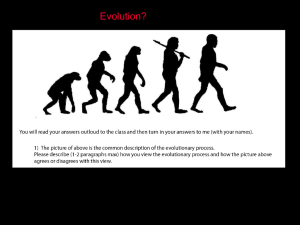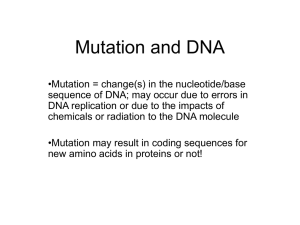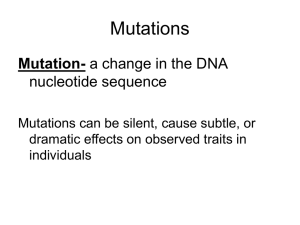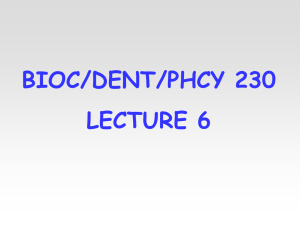Lecture 19 Spring 2011
advertisement
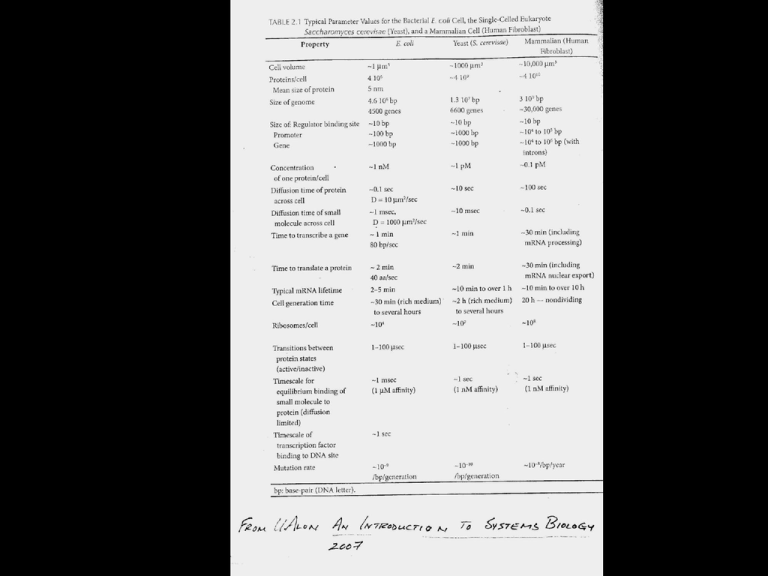
CsCl centrifugation of DNA over time developed by Meselson and Stahl In class question (extra credit) for Quiz #4 Question 1: (3pts) Why does one add EtBr to CsCl gradients for the isolation of plasmid DNA? Question 2: (4pts) Is an 8kb supercoiled plasmid more dense than a 3kb supercoiled plasmid. Yes/No (circle one) Will an 8kb supercoiled plasmid have more EtBr bound to it? Yes/No (circle one) We will talk about this again in a later lecture: But CsCl gradients are not the same thing as Sucrose Gradients or Agarose Gel Electrophoresis. CsCl centrifugation of DNA over time N15 is heavier than N14-Can be resolved in CsCl pulse-chase Experiment: Incubator with N15 containing medium for time, then chase with N14 medium Expt 1 grows Slowly Expt 2 Bacteria Grow Faster Why? Why would they do 2 different growth rates? Experiment 1 Experiment 2 N14 N15 only N14 N15 only Fuse Results from Expt 1 and 2 Cell Divisions N14 N15 only Experiment 1 observations Watson-Crick Model N14 N15 only Does Expt 1 prove hybrid formation? N15 dsDNA N15 ssDNA Critical Experiment: Hybrid Strand Separation And CsCl centrifugation Looks like control below What about N14/N15 hybrid? N14 ssDNA N15 ssDNA Evolution? The Molecular Basis of Mutation-Evolution Mutations alter the nucleotide sequences of genes in several ways, for example the substitution of one base pair for another or the deletion or addition or one or a few base pairs. Tautomeric Shifts Tautomeric Shifts Affect Base-Pairing Mutation Caused by Tautomeric Shifts Base Substitutions A transition replaces a pyrimidine with another pyrimidine or a purine for another purine. A transversion replaces a pyrimidine with a purine or a purine with a pyrimidine. Previously discussed Frameshift Mutations Factors Influencing the Rate of Spontaneous Mutations Accuracy of the DNA replication machinery Efficiency of the mechanisms for the repair of damaged DNA Degree of exposure to mutagenic agents in the environment Induced Mutations Induced mutations occur upon exposure to physical or chemical mutagens. Hermann J. Muller and Edgar Alternburg measured the frequency of X-linked recessive lethal mutations in Drosophila. Muller demonstrated that exposing Drosophila sperm to X-rays increased the mutation frequency. Chemical Mutagens Types of Chemical Mutagens Chemicals that are mutagenic to both replicating and nonreplicating DNA (e.g., alkylating agents and nitrous acid) Chemicals that are mutagenic only to replicating DNA (e.g., base analogs and acridine dyes) A Base Analog: 5-Bromouracil…it is more like Thymine! Mutagenic Effects of 5Bromouracil Nitrous Acid Causes Oxidative Deamination of Bases Intercalation of an Acridine Dye Causes Frameshift Mutations Alkylating Agents Alkylating agents are chemicals that donate alkyl groups to other molecules. Alkylating agents induce transitions, transversions, frameshifts, and chromosome aberrations. Alkylating of bases can change base-pairing properties. Alkylating agents can also activate error-prone DNA repair processes. Hydroxylamine Hydroxylamine is a hydroxylating agent. Hydroxylamine hydroxylates the amino group of cytosine and leads to G:C A:T transitions. The Electromagnetic Spectrum X-rays induce mutations through ionization. Ultraviolet light induces mutations through excitation- Energy addition. Irradiation Dosage and Mutation Frequency Ionizing Radiation Causes Changes in Chromosome Structure Ionizing radiation breaks chromosomes and can cause deletions, duplications, inversions, and translocations. These types of mutations display twohit kinetics. Thymine Dimers Mutagenesis by Ultraviolet Irradiation Hydrolysis of cytosine to a hydrate may cause mispairing during replication Cross-linking of adjacent thymine forms thymidine dimers, which block DNA replication and activate error-prone DNA repair mechanisms. Mutations Induced by Transposons Wrinkled Pea Previously discussed Expansion of Trinucleotide Repeats Simple tandem repeats are repeated sequence of one to six nucleotide pairs. Trinucleotide repeats can increase in copy number and cause inherited diseases. Examples: Fragile X Syndrome, Huntington disease, spinocerebellar ataxia These diseases are characterized by anticipation, the increased severity of disease or earlier age of onset in successive generations as the trinucleotide copy number increases. Mutations are induced by chemicals, ionizing irradiation, ultraviolet light, and endogenous transposable genetic elements. Point mutations are of three types: (1) (2) (3) Transitions—purine for purine and pyrimidine for pyrimidine substitutions, Transversions—purine for pyrimidine and pyrimidine for purine substitutions, and Frameshift mutations—additions or deletions of one or two nucleotide pairs, which alter the reading frame of the gene distal to the site of the mutation. You must know for your future Evolution? Alpha and Beta chain mutants…some of them Phylogenetic relationships How could we use GFP fluorescence to figure out-codon optimize GFP?
